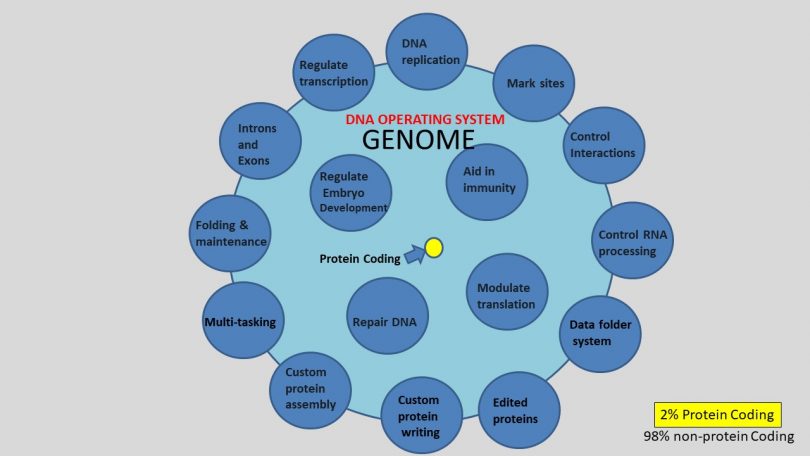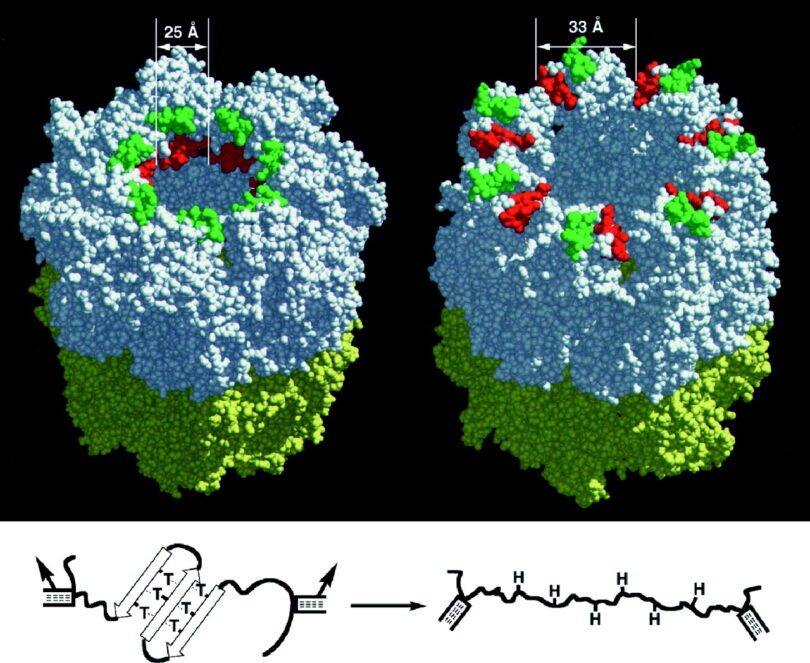What is “similar” in the genetic similarity exactly?
Genetic similarity compares a very small portion of the DNA sequence totaling a volume of 3.2 billion base pairs (in humans) of specified information programming digital letters.
Only about 1.2% of this total volume of DNA is used for comparisons in a region called The Genome.
This represents 34.8 million genetic letter sequences. When genetic similarities are made, only these protein assembly regions are compared. This tiny region is called The Genome. For genetic similarity comparisons, the balance of the vast 98.8% of the volume is simply considered “genetically irrelevant” and ignored. Many consider much of the DNA molecule, despite significant evidence to the contrary, to be “junk DNA”.
Junk DNA?
From a naturalistic perspective, vast segments of the molecule which are either not yet understood or unknown are often called “junk” DNA. Because there are many more unknown regions within the DNA molecule, initially they tossed over 98% of it out as “junk”!
Initially, all the remaining 98.8% of the DNA volume outside the protein-synthesizing genome was thought to be “junk DNA”.
Why such a quick presumption that most DNA is “junk”? Under the presumption that universal common descent evolution is correct, it made sense that perhaps these vast regions were garbage or past transmutational relics of a blind chance of trial and error. A junk yard for now unused genetic information. Of course, these claims have been soundly debunked. However, like many later recanted messages and clickbait of naturalism, these terms continue to be repeated despite empirical evidence the message is completely wrong.
…there used to be an older and derogatory term called junk DNA, which, thankfully, doesn’t (shouldn’t!) get used these days much longer. So really, the thing to keep in mind here that human genome is a vast, vast expanse of nucleotides, 3.3 billion…”
NIH Shurjo K. Sen, Ph.D. Program Director, Division of Genome Sciences, July 2022, Paranthesis and bold are mine.
What does the genome do?
The Genome is a vastly significant and important region of DNA because, despite its tiny 1.2% volume, in humans, it uses these approximately 34.8 million base pairs to provide programming blueprints to the cell.
Geneticists are yet illuminating epigenetic expressions outside the genome which can also directly cause a variance in protein structures.
Genome instructions provide the precise order to arrange amino acids into protein chains which are ultimately folded into three-dimensional structures which form all living material for all life.
The total volume of the DNA molecule is known to be more than 80% fully functional
From an intelligent design perspective, we believe most likely all the DNA sequences will eventually be found to be fully functional. Today it has already increased, in some estimates, to be more than 80% functional.1 As we stated before, many non-coding DNA sequences are known to serve functional roles including the regulation of gene expression. It has been shown that the exact base pair sequences can somehow cause different protein expressions while using even identical genetic coding sequences. Much of the mechanism behind protein synthesis is outside the genome residing in unexpressed RNA sequences.2
This means the genome alone does not reveal the depth of the construction of any living organism.
“Epigenetic processes, including DNA methylation, histone modification, and various RNA-mediated processes, are thought to influence gene expression chiefly at the level of transcription (are outside the genome).”
Gibney, E., Nolan, C. Epigenetics and gene expression. Heredity 105, 4–13 (2010). https://doi.org/10.1038/hdy.2010.54
Silent (“unexpressed”) RNA sequences stored in DNA can become activated only when very specific circumstances occur. This greatly weakens the assumptions made about the genome similarity between living organisms. It appears that these vast informational strings outside the genome, even outside the DNA molecule itself, serve as a vast library for variety used in part to ensure the survival of life during highly specific conditions. These discoveries leave very little room to argue why we should not expect to eventually discover that all DNA information will be eventually discovered to be fully functional.
“…over the last decade or so…we are only just starting to realize that there are an immense number of ways in which what we think of as non-coding (outside the genome) actually might just have a more subtle way of passing its information along. So it may not code in the classical protein-coding sense. But there is a ton of information crucial in many, many ways that is hidden in this part of the genome.
Shurjo K. Sen, Ph.D. Program Director, NIH Division of Genome Sciences; “Non-Coding DNA” July 2022-4
Sources
1- Birney, ENCODE Project Consortium,Bernstein, B. E., Birney, E., Dunham, I., Green, E. D., Gunter, C.,et al. (2012). An integrated encyclopedia of DNA elements in the human genome. Nature 489, 57–74. DOI: 10.1038/ nature11247.
2- Gibney, E., Nolan, C. Epigenetics and gene expression. Heredity 105, 4–13 (2010).


